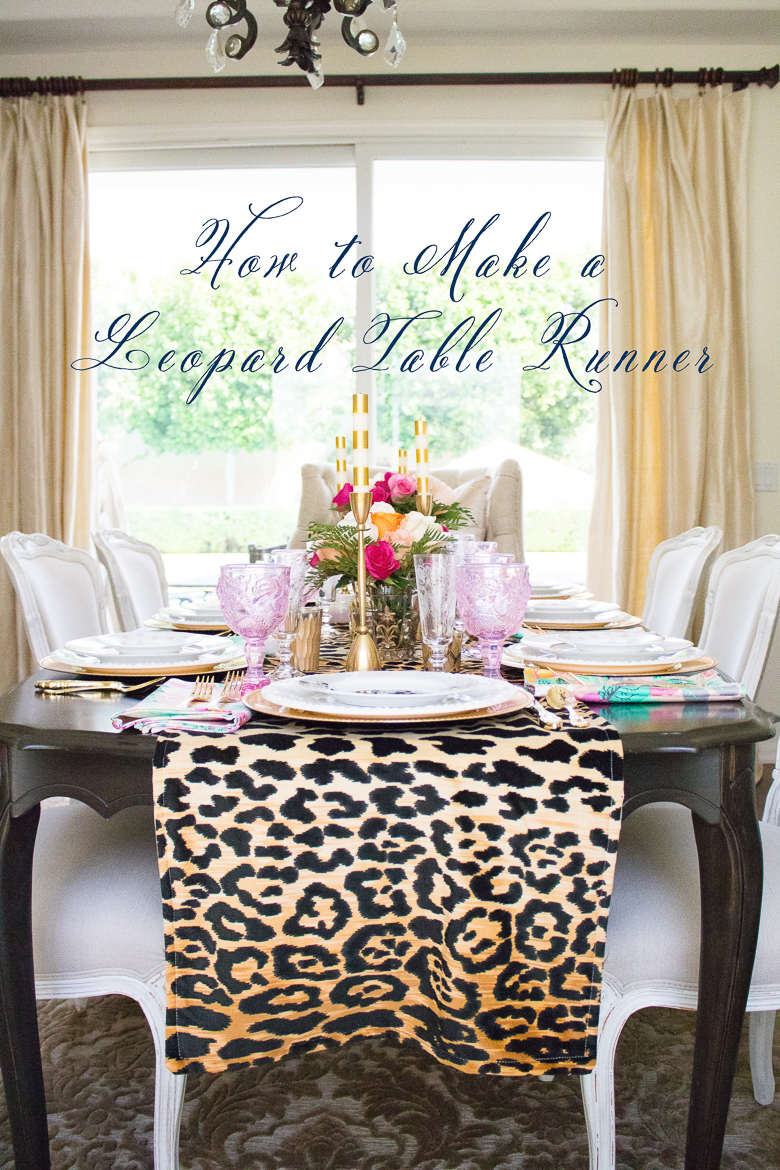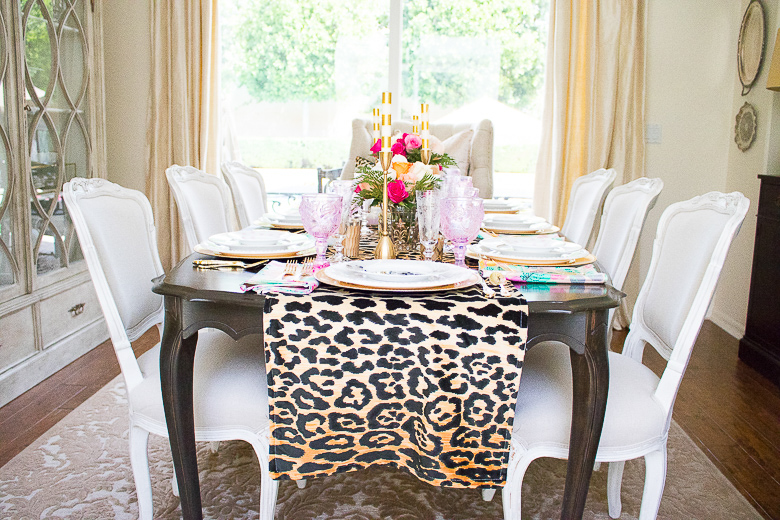
When I was in High School, my mom drove me to the local fabric store. She basically pushed me inside and told me to go apply for a job. My mom can do anything, really anything. I guess she thought I could too! The lady at the counter gave me an application, which asked general sewing questions. Let’s just say I didn’t get the job and I swore I’d never sew again.
Time healed that wound and I started sewing simple projects, like baby blankets for my babies. Nothing fancy, just projects with straight lines. As a newlywed with very little money, I wanted to decorate my house. I found some inexpensive fabric and made a simple table runner for my kitchen table.
Over the years, when I can’t find what I am looking for in the store, I make my own. It is so simple! If the girl who failed the fabric store simple sewing test can make it, you my friend can make one too! Follow my simple steps for how to make a leopard table runner and you will be able to make a table runner in any fabric for any season!

How to make a Leopard Table Runner
Step 1
Measure your table length. You want to add about 24 inches to the measurement of your table, so that the runner will hang off both ends. For example, if your table measures 80″, you would add 24 more inches for overhang. Your total measurement would be 104″.
Step 2
Decide how wide you want your runner to be. My runner is 18 inches wide (with the edges finished). You can make yours as wide as you like.
Step 3
Go to the fabric store and purchase your fabric or buy some online {this post contains affiliate links for your convenience}. I found mine here. Your measurements will determine how much fabric you will need. The lady at the fabric counter can help you figure that out. For my runner I used one yard of leopard fabric for the front and one yard of canvas fabric for the back.
Cut both fabrics (the leopard and the backing) into two pieces measuring 19″ wide and 54″ long. You will have 4 pieces, 2 leopard and 2 backing. Take the 2 leopard pieces and place them on top of each other so the right sides are facing together. Sew the two pieces together along the short edge, making one piece 108″ long. Repeat for the backing.
Having a seam in the middle of the runner allows you to use less fabric. It’s a good idea to wash all of your fabric first, to prevent shrinking.
Step 4
Cut your fabric to size.

You can use a rotary cutter, fabric cutting mat and fabric ruler to trim your fabric. If you don’t have those tools, use a good old yard stick, pen and scissors. First trim off the selvage edge (the edge of your fabric, as shown above). This will give you a nice straight edge to work with. Then measure the width of your fabric to your desired runner width. I wanted mine to be 18″ once it was sewn, so I cut my runner 19″ wide, giving extra room for the seams. Repeat with the fabric you are using for the back of your runner.

Step 5
Once your fabric is cut to size, lay the leopard piece on top of the backing, wrong sides together. You won’t see the leopard print. It will be facing down. See the picture below.

Step 6
Pin the two fabrics together. I place my pins every 3-4 inches all the way around. I also pin them about and inch in from the edge.
Step 7
Head to your sewing machine! Sew the two pieces together. I like to line the edge of my fabric up with the edge of my presser foot as a guide for a straight seam line. Sew around every edge until you get about 3 inches from where you started. Stop. Leave those 3 inches unstitched. Trim your thread.

Step 8
Take a pair of scissors and trim the 4 corners of your runner, being cautious not to trim the seam. This will allow your corners to lay flat.


Step 9
Find your 3 inch seam opening and flip your fabric inside out. I like to reach my hand inside and grab a corner and pull it out through the hole. Once it’s flipped inside out, flatten it out, smoothing out the edges.


Step 10
Go back to your sewing machine and repeat what you did in step 7, by sewing around all of the edges. When you get to the opening, tuck the edges under into the center and pin them down. Sew over the top. You may need to stitch the very edge of the runner as well so there is no chance of it opening there.

Voila!!! Your very own leopard table runner! It’s that easy! You can make as many table runners as your little heart desires, in any fabric you want!



Shop this table
***
Happy sewing!!! You can see all tablescape details here and a simple tutorial on how to make the floral arrangement here.
xo
Randi
*Don’t miss a post! Subscribe to our weekly email!
I am giving away a Daniel Wellington watch to one lucky email subscriber! If you are already signed up, you are automatically entered! Give away will close next Wednesday August 17 at 7 PST. Winner will be announced on my site next Wednesday night at 9 PST.


One thought on “How to Make a Leopard Table Runner”
Comments are closed.